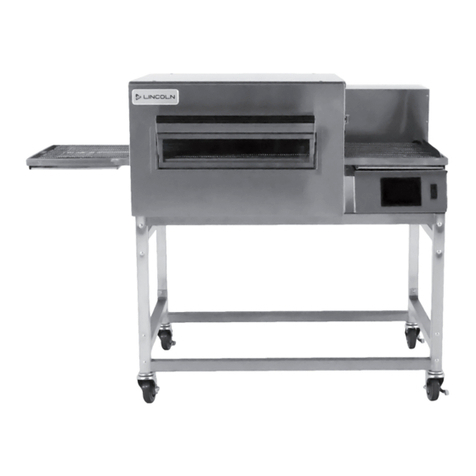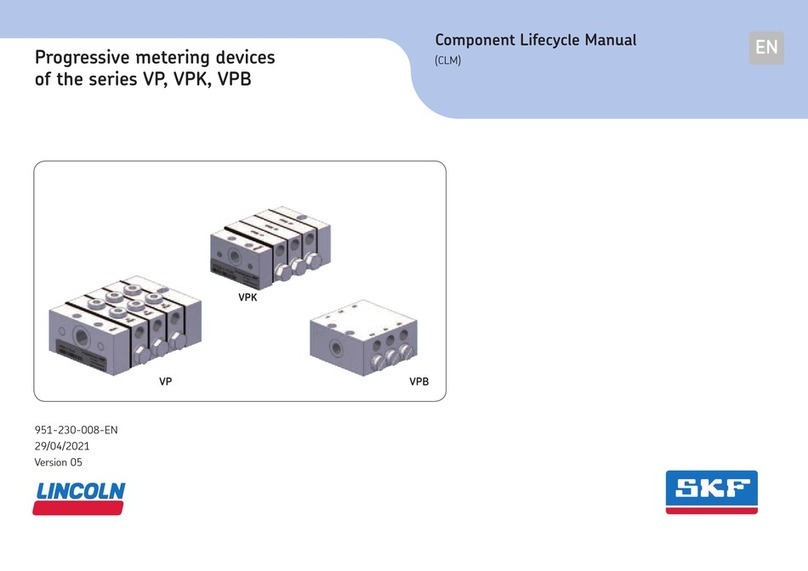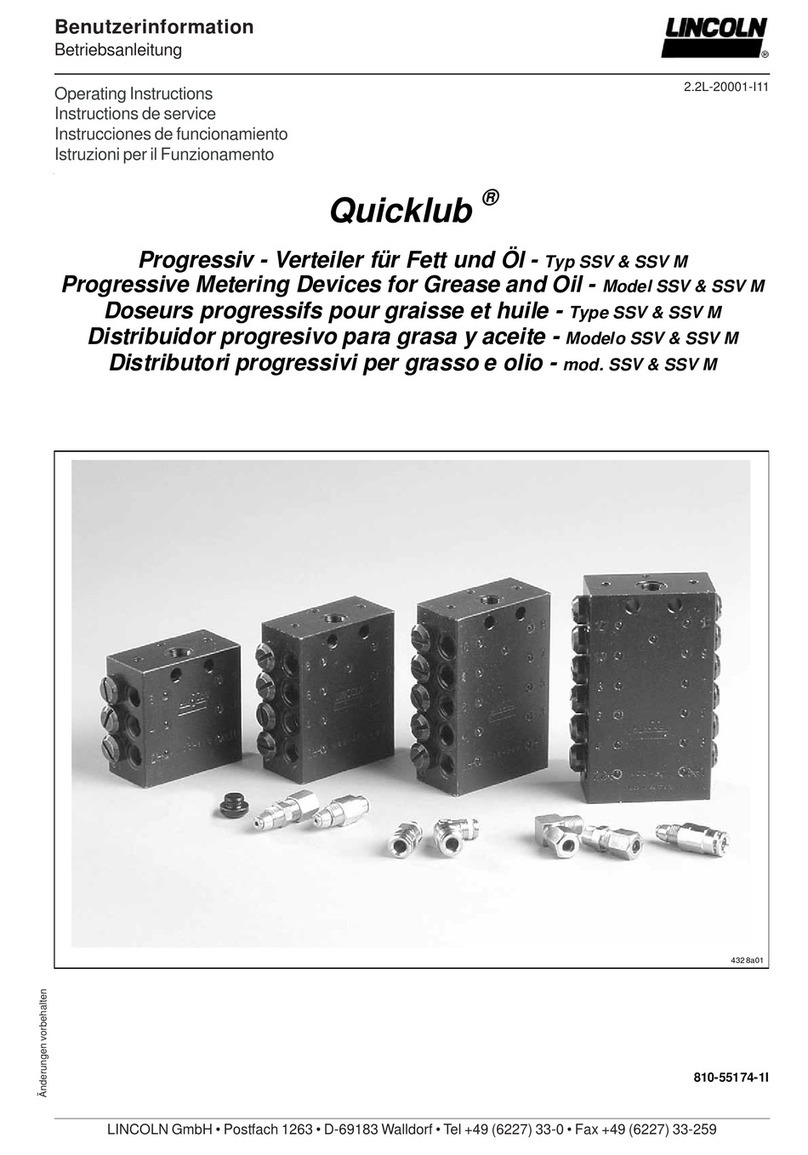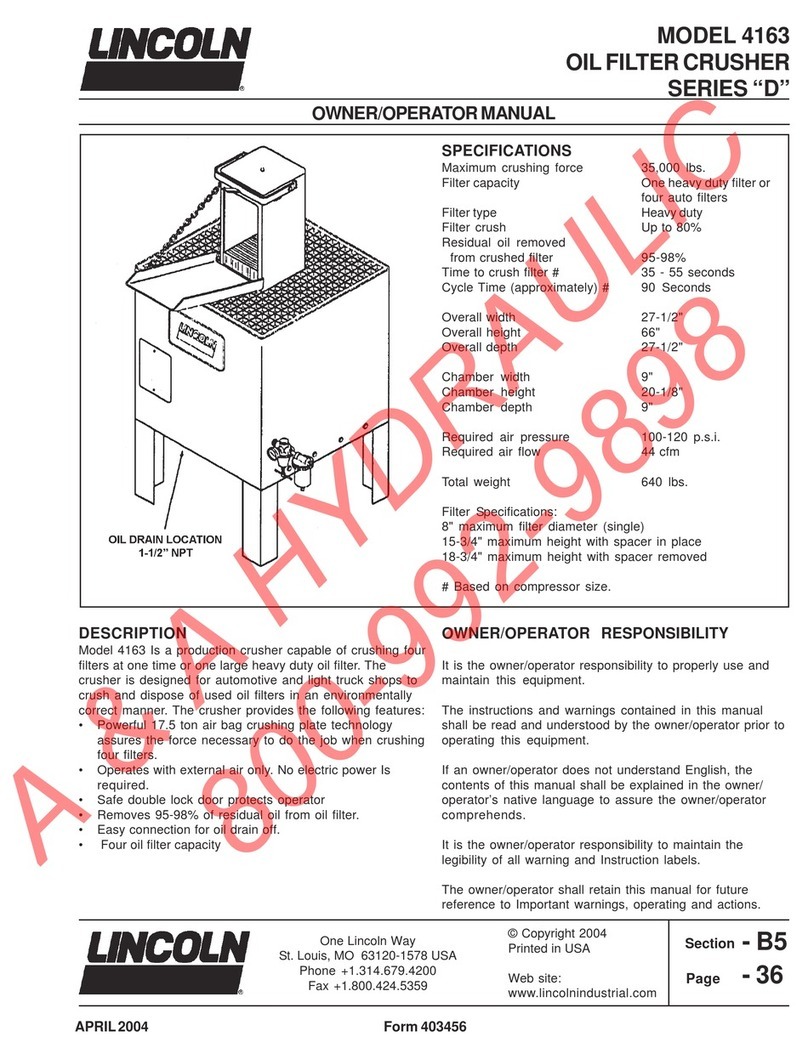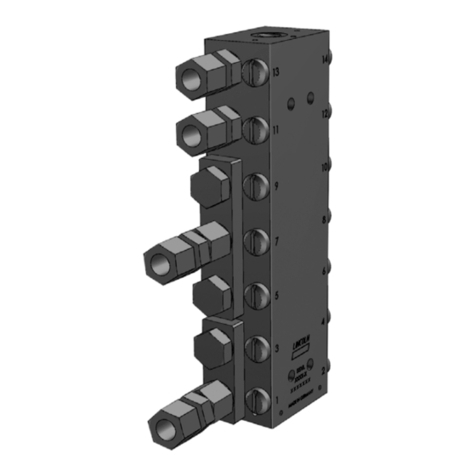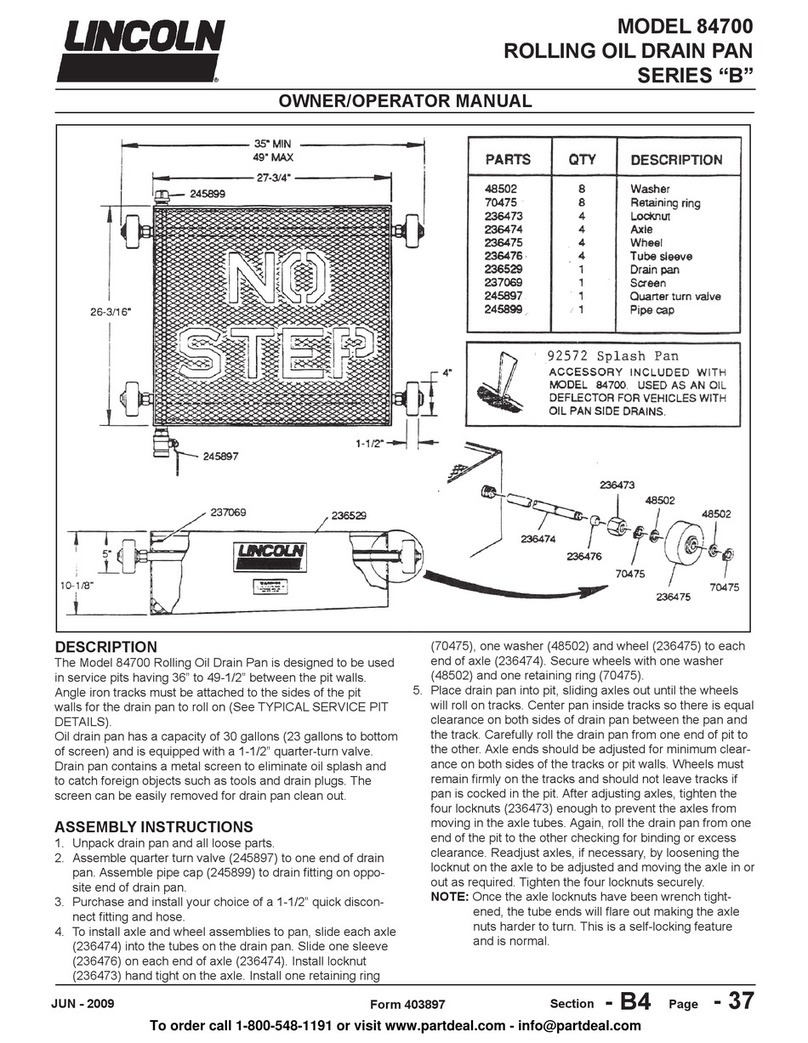Lincoln Quicklub SSV User manual

Subject to modifications
Owner Manual
OperatingInstructions
2.2A-10001-G07
LINCOLNGmbH•Postfach 1263• D-69183Walldorf•Tel+49 (6227)33-0 •Fax +49(6227) 33-259
Quicklub - Progressive Metering Devices
for Grease and Oil
Model SSV and SSV M, Planning and Layout
of Progressive Centralized Lubrication Systems
4328a01

Subject to modifications
Owner Manual
OperatingInstructions
2.2A-10001-G07
Page 2 of 36
LINCOLNGmbH •Postfach1263 •D-69183 Walldorf•Tel+49 (6227)33-0 •Fax +49(6227) 33-259
All rights reserved.
Any duplication of this User Manual, in its entirety or in part,
by whatever means is prohibited without the prior consent in
writing of Lincoln GmbH.
Subject to modifications without prior notification.
©
2007 by
L
INCOLN GmbH
P
ostfach 1263
D
-69183 Walldorf
Phone: +49 (6227) 33-0
Fax: +49 (6227) 33-259

Subject to modifications
Owner Manual
OperatingInstructions
2.2A-10001-G07
LINCOLNGmbH •Postfach 1263• D-69183Walldorf•Tel+49 (6227)33-0 •Fax +49(6227) 33-259
Page 3 of 36
Table of Contets
Page
Introduction ..................................................................... 4
Explanation of Symbols Used ............................................ 4
User’s Responsibility ......................................................... 4
Environmental Protection .................................................. 4
Service .............................................................................. 4
Safety instructions.......................................................... 5
Appropriate Use ................................................................ 5
General Safety Instructions ............................................... 5
Accident Prevention Regulations ....................................... 5
Operation, Maintenance, Repair ........................................ 5
Installation ......................................................................... 6
Installation ....................................................................... 6
Tube Fittings, Screw-Type ................................................. 7
Main- and secondary Metering devices ....................... 7
Tube Fittings, Push-in Type ............................................... 7
Metering Devices ......................................................... 7
Connection of the High-pressure Hose and
the Pressure Plastic Tube ............................................ 7
Pressure Plastic Tubes and High-pressure Hoses ............ 8
Description ....................................................................... 9
Progressive Metering Devices Model SSV and SSV M ..... 9
Progressive Plunger Metering Devices – General ....... 9
Features of a Progressive Metering Device ................. 9
Page
Operation .........................................................................11
Applications ...................................................................... 11
Lubricant Distribution within the Metering Device ............ 13
Phase 1 + 2 ................................................................ 13
Phase 3 - 5 ................................................................. 14
Monitoring of the Operation ............................................. 15
System-dependent monitoring ................................... 15
Visual monitoring ........................................................ 15
Electrical monitoring (microprocessor control) ........... 16
Pressure relief valve ................................................... 16
Determining the Lubricant Output by Combining Outlets 17
Tube Fittings, Screw-Type ......................................... 17
Tube Fittings, Push-in-Type (main metering device) .. 18
Tube Fittings, Push-in-Type
(secondary metering devices) .................................... 19
Planning and Layout ...................................................... 20
Instructions for Quicklub Progressive Systems ................ 20
Troubleshooting ............................................................. 29
Technical Data ................................................................ 31
Metering Devices ............................................................. 31
Screw-Type and Push-in-Type Tube Fittings ................... 31
Lines ................................................................................ 31
Tightening torques ........................................................... 31
Dimensions ...................................................................... 32
Metering Devices Model SSV 6 to SSV 22.................. 32
Metering Devices SSV M 6 to SSV M 12 ................... 32
List of Lubricants ........................................................... 33
Further Information can be found in the following manuals:
Technical Description Quicklub - Pump 203
Technical Description for “Electronic Control Units” of pump 203:
Printed-Circuit Board 236-13857-1 - Variant H 1)
Printed-Circuit Board 236-13862-1 - Variant V10 - V13 1)
Printed-Circuit Board 236-13870-1 - Variant M 08 - M 15 1)
Printed-Circuit Board 236-13870-1 - Variant M 16 - M 23 1)
Installation Instructions
Parts Catalogue
1) The model designation of the printed-circuit board is part of the pump model designation indicated on the pump nameplate.
Example: P 203 - 2XN - 1K6 - 24 - 1A1.10 - V10

Subject to modifications
Owner Manual
OperatingInstructions
2.2A-10001-G07
Page 4 of 36
LINCOLNGmbH •Postfach1263 •D-69183 Walldorf•Tel+49 (6227)33-0 •Fax +49(6227) 33-259
Introduction
Explanation of Symbols Used
The following description standards are used in this manual:
Safety Instructions
Structure of safety instructions:
Pictogram
Signal word
Danger text
- Danger note
- How to avoid danger
The following pictograms are used in this manual and are
combined with the corresponding signal words:
1013A94
4273a00
6001a02
- ATTENTION
- CAUTION
- WARNING
- ATTENTION
- CAUTION
- WARNING
- NOTE
- IMPORTANT
The signal words give the seriousness of danger if the follow-
ing text is not observed:
ATTENTION refers to faults or damages on
machines.
CAUTION refers to bad damages and possi-
ble injuries.
WARNING refers to possible dangerous inju-
ries.
NOTE indicates improved operation of the
device.
IMPORTANT indicates special operating fea-
tures of the device.
Example:
1013A94
ATTENTION!
When making use of other than the tested
spare parts, serious damage may affect
your device.
Therefore, for the operation of your device
always use original spare parts made by
Lincoln GmbH.
Furthermore, you will find the following text symbols in this
manual:
Listing of applicable statements
- Subpoint of applicable statements
1. Determination of the number or sequence of contents
ÂProcedural instruction
User's Responsibility
To ensure the safe operation of the unit, the user is responsi-
ble for the following:
1. The pump / system shall be operated only for the in-
tended use (see next chapter "Safety Instructions") and
its design shall neither be modified nor transformed.
2. The pump / system shall be operated only if it is in a
proper functioning condition and if it is operated in accor-
dance with the maintenance requirements.
3. The operating personnel must be familiar with this Owner
Manual and the safety instructions mentioned within and
observe these carefully.
The correct installation and connection of tubes and hoses, if
not specified by Lincoln GmbH, is the user's responsibility.
Lincoln GmbH will gladly assist you with any questions per-
taining to the installation.
Environmental Protection
Waste (e.g. used oil, detergents, lubricants) must be dis-
posed of in accordance with relevant environmental regula-
tions.
Service
The personnel responsible for the handling of the pump /
system must be suitably qualified. If required, Lincoln GmbH
offers you full service in the form of advice, on-site installation
assistance, training, etc. We will be pleased to inform you
about our possibilities to support you purposefully.
In the event of inquiries pertaining to maintenance, repairs
and spare parts, we require model specific data to enable us
to clearly identify the components of your pump / system.
Therefore, always indicate the part, model and series number
of your pump / system.

Subject to modifications
Owner Manual
OperatingInstructions
2.2A-10001-G07
LINCOLNGmbH •Postfach 1263• D-69183Walldorf•Tel+49 (6227)33-0 •Fax +49(6227) 33-259
Page 5 of 36
Safety Instructions
Appropriate Use
Use the SSV and SSV M lubricant metering devices only for
dispensing lubricants in centralized lubrication systems.
Suitable Lubricants
The progressive metering devices model SSV can be used
for dispensing
- mineral oils of at least 40 mm²/s (cST) or
- greases up to the penetration class NLGI 2
6001a02
IMPORTANT
It must nevertheless be ensured that the
oils or greases used do not alter their con-
sistency significantly in the course of time o
r
under the influence of temperature or
pressure.
General Safety Instructions
The progressive centralized lubrication system connected
to the Quicklub pump model 203 must always be secured
with a pressure relief valve.
Lincoln SSV and SSV M lubricant metering devices are
state of the art.
Incorrect use may result in bearing damage caused by
poor or over-lubrication.
Each outlet which will be used must be equipped with a
check valve.
In the case of the metering devices model SSV 6 - 12
the outlets 1 and/or 2 must never be closed. In the case of
the assembled metering devices model SSV 14 - 22,
the two outlets with the highest numbers must never be
closed.
Unauthorized modifications or changes to an installed
system are not admissible. Any modification must be
subject to prior consultation with the manufacturer of the
lubrication system.
Use only original Lincoln spare parts (see Parts Catalogue)
or the parts approved by Lincoln.
Regulations for Prevention of Accidents
Adhere to the regulations forpreventionof accidents which are
effective in the country where the system is to be used.
1013A94
CAUTION!
Danger of injury in the case of serious
corrosion of metering device surfaces:
A
n increasing corrosion of the surfaces will
cause the balls pressed in to lose their hold.
Under pressure, they may suddenly burst
out and cause injuries.
For applications in corrosive environments,
use metering devices in stainless steel
version only.
Operation, Repair and Maintenance
Authorized and instructed personnel who are familiar with the
centralized lubrication systems should only perform repair.
Installation
Install the metering devices at a suitable location in ac-
cordance with the lubrication diagram.
It is recommended that the metering devices be installed in
such a way that the outlets are not close to the chassis or
the attaching plate. This will facilitate troubleshooting in the
case the system is blocked.
The main metering devices with indicator pin must be
installed in such a way that the indicator pin is easily visible.
When the push-in type fittings are used, note the follow-
ing:
For the metering device inlet use only push-in type
fittings (R 1/8) with reinforced collar and sealing ring.
For the outlet tube fittings of the SSV divider valve
(M 10x1) depending on the design of the lubricant line, for
example
- high-pressure plastic hose (ø 4.1 x 2.3) use valve bodies
with reinforced collar only, or,
- pressure plastic tube (ø 6 x 1.5) use valve bodies with
knurled collar only
For the outlet fittings of the SSV M divider divider valve
(M 8x1) pressure plastic tube (ø 4 x 1) use valve bodies
with knurled collar only.
6001a02
NOTE
In the case of construction machines or
agricultural machines use high pressure
plastic hoses for the lubricant feet lines. In
such cases the outlet fittings of the sec-
ondary metering devices and the connec-
tion fittings to the lubricant points must
have a reinforced collet.
Use only the main and feed lines specified by Lincoln and
adhere to the specified system pressures.

Subject to modifications
Owner Manual
OperatingInstructions
2.2A-10001-G07
Page 6 of 36
LINCOLNGmbH •Postfach1263 •D-69183 Walldorf•Tel+49 (6227)33-0 •Fax +49(6227) 33-259
Installation
Tube Fittings, Screw-Type
4239a99
Fig. 1 Single parts of the check valve
Main- and secondary Metering devices
Inlet tube fittings, straight and 90°
As inlet fitting use only tube fittings R1/8” thread.
Check valves
Install one complete check valve in each outlet borehole
which will be used.
Install one closure plug in each outlet borehole which will be
not used. Exception: outlet bore hole 1 and/or 2 on SSV 6 to
SSV 22. In both boreholes check valves have to be installed.
Check valves for tube dia. 4 mm and 6 mm are available.
1 - coupling nut
2 - ferrule 3 - valve body with seal and
clamp ring
Tube Fittings, Push-in Type
1008a98
Fig. 2 Inlet fittings
1009a98
Fig. 3 The different types of check valve
Metering Devices
Inlet tube fittings, straight and 90 °
6001a02
IMPORTANT
For the inlet fittings use only tube fittings
with reinforced collet 1a (Fig. 2) and
sealing ring 1b at the thread.
1a - Collet
1b - Sealing ring
Check valves
Main metering device
Use check valves type A, Fig.3 with reinforced collet 1a
and smooth flange (Part no. 226-14091-4).
Secondary metering device
Use check valves type B, Fig. 3 with standard collet 2a
and knurled flange (Part no. 226-14091-2).
6001a02
NOTE
On construction machines or agricultural
machines use high-pressure hoses. In
such cases the check valves of the secon-
dary metering devices must have a rein-
forced collet and smooth flange.
A - Check valve with reinforced collet
B - Check valve with knurled collet
1a - reinforced collet
2a - knurled collet

Subject to modifications
Owner Manual
OperatingInstructions
2.2A-10001-G07
LINCOLNGmbH •Postfach 1263• D-69183Walldorf•Tel+49 (6227)33-0 •Fax +49(6227) 33-259
Page 7 of 36
Installation, continuation
Tube Fittings, Push-in Type, continuation
Connection of the High-pressure Hose and the Pressure Plastic Tube
4156a98
Fig. 4 Check valve with reinforced collet and hose stud
High-pressure range (main metering device)
6001a02
IMPORTANT
Connect only high-pressure hoses (ø 4.1 x
2.3 mm) with threaded sleeve and hose
studs may be connected to the inlet fitting
and to the check valves with reinforced
collar.
4157a98
Fig. 5 Check valve with knurled collet and pressure plastic tube
Low-pressure range (secondary metering device)
Connect the pressure plastic tube (ø 6 x 1.5 mm) to the check
valve with standard collet (knurled collet) and to the inlet
fittings towards the lubrication point (knurled collet).
6001a02
NOTE
Exceptionally the high-pressure hose
(ø 4.1 x 2.3 mm) with threaded sleeve and
hose stud may also be used for the low-
pressure section. Applications for construc-
tion machines or agricultural machines,
however, require the use of check valves
and inlet fittings (towards the lubrication
point) with reinforced collet for the low-
pressure range. Refer to Parts Catalog.
The pressure plastic tubes are marked with white lines
(Fig. 5) as an installation aid.
ÂCut the pressure plastic tube off at one of the white lines
before it is mounted. Then insert the plastic pressure tube
into the fitting up to the next white mark. This will ensure a
correct installation of the pressure plastic tube in the
threaded tube fitting.
00002632
Fig. 6 Push-in type fitting with protection cap
Protection Cap for Push-in Type Fittings
To prevent dirt from entering the systen, the push-in type
fittings, check valves and pressure relief valves can be
equipped with protective caps.

Subject to modifications
Owner Manual
OperatingInstructions
2.2A-10001-G07
Page 8 of 36
LINCOLNGmbH •Postfach1263 •D-69183 Walldorf•Tel+49 (6227)33-0 •Fax +49(6227) 33-259
Installation, continuation
Pressure Plastic Tubes and High-pressure Hoses
Pressure Plastic Tube Ø 6 x 1.5 mm
Use the pressure plastic tubes only in the low-pressure area, i.e. between the secondary metering devices and the lubrica-
tion point.
Adhere to the pressures and bending radiuses mentioned in the chapter “Technical Data” when installing the parts.
High-pressure hose Ø 4.1 x 2.3 mm
1028a96
Fig. 7 Preassembly of the threaded sleeves and hose studs on
the high pressure hose
1 - Threaded sleeve
2 - High-pressure hose Ø 4.1 x 2.3 mm
3 - Hose stud
Use the high-pressure hose in the high-pressure area, i.e.
between the pump, main metering device and secondary
metering devices.
Adhere to the pressures and bending radiuses mentioned
in the chapter “Technical Data” when installing the parts.
Installing the threaded sleeves and hose studs on the
high pressure hose
Screw the threaded sleeve, item 1 Fig. 30, counter clock-
wise onto the high-pressure plastic hose 2 until the illus-
trated dimension of 11 mm is reached. Then screw the
hose stud 3 into the threaded sleeve 1.
IMPORTANT
Before screwing the parts 1 and 3, rub
them with oil.
6001a02 NOTE
The outside diameter of the high-pressure
hose may show variations in dimension. In
such a case, press the threaded sleeve 1
at the end where it will be screwed onto
the high-pressure hose so that it becomes
oval in shape (1 to 2 mm). This will preven
t
the high-pressure hose from being pushed
out of the sleeve when the hose stud is
screwed.
1029a96
Fig. 8 Preassembly of the threaded sleeve by means of an ad-
justing gauge
1 - Threaded sleeve
2 - High-pressure hose Ø 4.1 x 2.3 mm
3 - Adjusting gauge 432-23077-1
6001a02
NOTE
When using the special adjusting gauge
432-23077-1 (see Parts Catalogue) screw
the threaded sleeve counter clockwise
onto the high pressure hose until the
gauge inserted in the sleeve begins to rise.

Subject to modifications
Owner Manual
OperatingInstructions
2.2A-10001-G07
LINCOLNGmbH •Postfach 1263• D-69183Walldorf•Tel+49 (6227)33-0 •Fax +49(6227) 33-259
Page 9 of 36
Description
Progressive Metering Devices Model SSV and SSV M
10002709
Fig. 9 Metering device type SSV 8 shown as a demonstration
model
Progressive Plunger Metering Devices - General
The progressive metering devices
- are piston-operated metering devices;
- automatically (progressively) dispense the lubricant fed
by the pump to the connected lubrication points;
- model SSV have a lubricant output of 0.2 cm³ per
outlet and piston stroke;
- model SSV M have a lubricant output of 0.07 cm³ per
outlet and piston stroke;
- when one or more outlets are closed (see ”Combining
outlets”) they can dispense a double or multiple lubri-
cant quantity;
- are available with 6 to 12 outlets or up to 22 outlets;
- offer the option of combining several lubrication points
into one centralized lubrication point.
- meter the supplied lubricant into predetermined single
quantities.
- can be monitored visually (SSV and SSV M)or elec-
tronically (only SSV).
Any blockage in a lubrication circuit is indicated by grease
leaking from the respective pressure relief valve.
10002710
Fig. 10 Sectional view of a SSV 8 metering device
Features of a Progressive Metering Device
The term ”progressive” refers to the special features of
the lubricant distribution within the metering devices,
e.g.
- the successive movements of the individual pistons
within the metering device due to the supplied lubricant
being under pressure;
- the pistons move in a predetermined order and the cy-
cles are repeated constantly;
- each piston must have completed its movement fully
before the next piston can be moved, no matter whether
the lubricant is dispensed continuously or intermittently;
- the pistons operate interdependently of one another;
- no lubrication point which is connected to the system is
omitted.

Subject to modifications
Owner Manual
OperatingInstructions
2.2A-10001-G07
Page 10 of 36
LINCOLNGmbH •Postfach1263 •D-69183 Walldorf•Tel+49 (6227)33-0 •Fax +49(6227) 33-259
Description, continuation
Progressive Metering Devices Model SSV and SSV M, continuation
4330a01
Fig. 11 Differences between SSV M and SSV
Different of Features from SSV M - SSV
Progressive divider valves SSV M and SSV operate in
the same way. Apart from their outer dimensions (see be-
low dimensions) they also differ in the following data (also
see fig. 11).
SSV
Lubricant output per outlet and per stroke .................... 0.2cm³
Max. operating pressure..............................................350 bar
Min. operating pressure.................................................20 bar
Max. differential pressure between two outlets............100 bar
Outlet connection for tube..................................Ø 4 and 6 mm
SSV M
Lubricant output per outlet and per stroke .................. 0.07cm³
Max. operating pressure..............................................200 bar
Min. operating pressure.................................................20 bar
Max. differential pressure between two outlets..............40 bar
Outlet connection for tube............................................Ø 4 mm

Subject to modifications
Owner Manual
OperatingInstructions
2.2A-10001-G07
LINCOLNGmbH •Postfach 1263• D-69183Walldorf•Tel+49 (6227)33-0 •Fax +49(6227) 33-259
Page 11 of 36
Operation
Applications
1205a95
Fig. 12 Central lubrication point
Quicklub progressive metering devices offer the option of
combining several lubrication points on a machine to one
or more central lubrication points, as shown in Fig. 12,
which illustrates this basic feature.
4024b95
Fig. 13 Possible pump connections
When they are used in connection with hand-operated
pumps, pneumatic or electric pumps the progressive me-
tering devices are a simple and low-cost centralized lubri-
cation system. See Fig. 13.
1 - Hand-operated pump
2 - Pneumatically operated pump
3 - Electrically operated pump
4 - Lubrication fitting block
5 - Hand-operated filling pump
4025a95
Fig. 14 Multiline pump expanded by a progressive metering device

Subject to modifications
Owner Manual
OperatingInstructions
2.2A-10001-G07
Page 12 of 36
LINCOLNGmbH •Postfach1263 •D-69183 Walldorf•Tel+49 (6227)33-0 •Fax +49(6227) 33-259
Operation, continuation
Applications, continuation
1207a95
Fig. 15 Two-line system expanded by a progressive metering
device
Progressive metering devices can be used in two-line or
single-line centralized lubrication systems in order to in-
crease the number of outlets of multiline pumps or to sub-
divide the single metering devices and measuring valves
(Fig. 12 to 16) also as secondary metering devices in
large and small oil circulating systems.
1206a95
Fig. 16 Single-line system expanded by a progressive metering
device

Subject to modifications
Owner Manual
OperatingInstructions
2.2A-10001-G07
LINCOLNGmbH •Postfach 1263• D-69183Walldorf•Tel+49 (6227)33-0 •Fax +49(6227) 33-259
Page 13 of 36
Operation, continuation
Lubricant Distribution within the metering Device
The 5 following illustrations show how the lubricant distribu-
tion is made to the individual outlets.
When the lubricant supply is interrupted
- the pistons come to a halt;
- the lubricant is no longer dispensed to the lubrication
point.
When the lubricant is fed again to the metering device, the
cycle begins from the point where it had been interrupted.
6001a02
NOTE
To simplify the description we only show
the lubricant distribution for outlets 2, 7, 5,
3 and 1. The remaining distribution opera-
tions are derived from the logical pumping
sequence.
2007a99
Fig. 17 Phase 1
Phase 1
The lubricant enters the metering device from above
(white arrow) and flows to the right-hand end of piston A.
Piston A (black arrow) is moved to the left under the pres-
sure of the lubricant, causing the lubricant ahead of the
left-hand end of piston A to be dispensed to outlet 2
(dashed arrow).
Lubricant under pump pressure
Lubricant under delivery pressure of the piston
Lubricant, pressureless
2008a95
Fig. 18 Phase 2
Phase 2
Once piston A has reached its left-hand final position, the
junction channel to the right-hand end of piston B is
opened.
The lubricant which arrives from above (white arrow) also
moves piston B (black arrow) to the left, causing the lubri-
cant quantity ahead of the left-hand end of piston B to be
dispensed to outlet 7 (dashed arrow).
Lubricant under pump pressure
Lubricant under delivery pressure of the piston
Lubricant, pressureless

Subject to modifications
Owner Manual
OperatingInstructions
2.2A-10001-G07
Page 14 of 36
LINCOLNGmbH •Postfach1263 •D-69183 Walldorf•Tel+49 (6227)33-0 •Fax +49(6227) 33-259
Operation, continuation
Lubricant Distribution within the Metering Device, continuation
2009a95
Fig. 19 Phase 3
Phase 3
Once piston B has reached its left-hand final position, the
junction channel to the right-hand end of piston A is
opened.
The lubricant, which flows from above (white arrow)
moves piston C (black arrow) to the left, causing the lubri-
cant quantity ahead of the left-hand end of piston C to be
dispensed to outlet 5 (dashed arrow).
Lubricant under pump pressure
Lubricant under delivery pressure of the piston
Lubricant, pressureless
2010a95
Fig. 20 Phase 4
Phase 4
The channel to the right-hand end of piston D is now open
(black arrow).
The lubricant which is fed from above (white arrow)
moves piston D to the left, causing the lubricant quantity
ahead of the left-hand end of piston D to be dispensed out
of the metering device via outlet 3 (dashed arrow).
Lubricant under pump pressure
Lubricant under delivery pressure of the piston
Lubricant, pressureless
2011a95
Fig. 21 Phase 5
Phase 5
In phase 4, piston D had opened the junction channel to
the left-hand end of piston A.
The lubricant flowing in (white arrow) moves piston A to
the right (black arrow), causing the lubricant quantity to be
dispensed to outlet 1(dashed arrow).
In the subsequent distribution sequence, pistons B - D are
moved from the left to the right one after the other.
A complete distribution sequence is finished and a new
cycle can begin.
Lubricant under pump pressure
Lubricant under delivery pressure of the piston
Lubricant, pressureless

Subject to modifications
Owner Manual
OperatingInstructions
2.2A-10001-G07
LINCOLNGmbH •Postfach 1263• D-69183Walldorf•Tel+49 (6227)33-0 •Fax +49(6227) 33-259
Page 15 of 36
Operation, continuation
Monitoring of the Operation
1064b95
Fig. 22 Example of a lubrication system
System-dependent monitoring
The main metering device (B, Fig. 23) and the secondary
metering devices are connected by a high-pressure
hose G. This feature automatically causes the linkage of
the progressive system connected downstream of the
pump.
If only one piston does not move in any metering device
or if the metering device can no longer dispense any lu-
bricant via its outlets, this metering device will block itself.
If one of the secondary metering devices is blocked, the
main metering device is also blocked. The whole progres-
sive system installed downstream of the pump stops op-
erating.
The fundamental internal structure of the progressive
metering device guarantees the self-monitoring of the se-
quence within the metering device.
The linkage makes it possible to monitor the operation of
the whole system.
A - pressure relief valve B - Main metering device SSV 6
C - Secondary metering device
SSV 8 D - Secondary metering device
SSV 6
E - Pressure plastic tube F - Secondary metering device
SSV 12
G - High pressure plastic hose
1011b96
Fig. 23 Indicator pin installed on metering device
Visual monitoring
The metering devices can be equipped with an indicator
pin which is connected to the piston and moves back and
forth during lubricant distribution.
If there is a blockage in the system, the indicator pin stops
moving.
6001a02
NOTE
It is also possible to electrically check the
movements of the indicator pin or any
blockage in the system by means of a
control switch (KS) or a proximity switch
(KN).
Components of the control pin tube fitting
Closure plug M 11x1x5 MS, assy. (pos. 1) .........519-32123-1

Subject to modifications
Owner Manual
OperatingInstructions
2.2A-10001-G07
Page 16 of 36
LINCOLNGmbH •Postfach1263 •D-69183 Walldorf•Tel+49 (6227)33-0 •Fax +49(6227) 33-259
Operation, continuation
Monitoring of the Operation, continuation
00002634
Fig. 24 Piston detector installed on the metering device
Electrical monitoring (microprocessor control)
A piston detector (initiator) which has been installed on a
metering device instead of a piston closure plug
(M 11 x 1) monitors the pump operating time and brings
it to a close after all the pistons of this metering device
have dispensed their lubricant quantity.
If there is a blockage in the system or if the pump reser-
voir is empty, the piston detector can no longer record the
piston movements. The switching off signal is not trans-
mitted to the control unit. A fault signal occurs.
6001a02
NOTE
For the system monitoring it is recom-
mended that one SSV metering device
with pre-assembled piston detector be
used per lubrication circuit. These special
metering devices must be ordered sepa-
rately for each lubrication system. Refer to
the Parts Catalogue.
The pre-assembled metering devices have the designa-
tion SSV ... - N (they are available for SSV 6, 8, 10
and 12). They must be installed in the system instead of a
normal metering device.
4092a97
Fig. 25 Pressure relief valve
Pressure relief valve
The whole system can be monitored visually via the pres-
sure relief valve. If lubricant is leaking at the pressure re-
lief valve during the distribution sequence, this indicates
that there is a blockage in the system.
6001a02
IMPORTANT
In the case of the progressive metering
devices models SSV 6 - 22 the outlets 1
and/or 2 must never be closed, other-
wise the system would block owing to the
structure of the metering device.

Subject to modifications
Owner Manual
OperatingInstructions
2.2A-10001-G07
LINCOLNGmbH •Postfach 1263• D-69183Walldorf•Tel+49 (6227)33-0 •Fax +49(6227) 33-259
Page 17 of 36
Operation, continuation
Determining the Lubricant Output by Combining Outlets
Tube Fittings, Screw-Type
1012c96
Fig. 26 Install the outlet fittings and closure plugs in accordance with the dosage
1 - Inlet fitting 4 - Closure plug (M 11 x 1), piston
(with chamfered) 8 - Coupling nut
2 - Delivery hole of the piston 5 - Outlet fitting assembly 9 - Junction channel
3 - Closure plug, installed
with copper washer 6 - Valve body with clamping ring (brass)
7 - Cutting ring 10 - New closure plug with hex. socket
head, replacement for pos. 3
The output quantities can be raised by closing outlet
boreholes.
Install an outlet fitting assembly 5 (M 10x1) in each outlet
borehole which will be used. Refer to Fig. 26, 27, 28.
Never remove closure plug 4 (M 11x1 chamfered) on
the piston side or remove it only for installing a piston de-
tector.
6001a02
NOTE
Never use closure plug 3 (M 10 x 1,
Fig. 20, 21) as a piston closure plug 4 (G
1/8) on older models of metering devices.
IMPORTANT
Always use valve body (Fig. 26) in con-
j
unction with clamping ring.
Clamping ring (Fig. 26) closes the junction channels 9 to
the other outlet channels.
6001a02
NOTE
In the case of push-in type fittings the
clamping ring is always a firm component
part of the valve body.
IMPORTANT
In the case of the progressive metering
devices model SSV 6 - 22 the outlets 1
and/or 2 must never be closed. In the
case of the assembled progressive meter-
ing devices model SSV 14 – 22 (if any),
the two outlets with the highest num-
bers must never be closed, otherwise the
system would block due to the structure of
the metering device.

Subject to modifications
Owner Manual
OperatingInstructions
2.2A-10001-G07
Page 18 of 36
LINCOLNGmbH •Postfach1263 •D-69183 Walldorf•Tel+49 (6227)33-0 •Fax +49(6227) 33-259
Operation, continuation
Determining the Lubricant Output by Combining Outlets , continuation
Tube Fittings, Push-in-Type (main metering device)
1203c95
Fig. 27 Install the push-in type outlet fittings and the closure plugs in accordance with the dosage
1 - Inlet fitting (optionally with protective
cap1)) 3 - Closure plug with copper
washer installed in outlet borehole 6 - Junction channels
2 - Delivery borehole of the piston 4 - Closure plug (M 11x1),
piston, (chamfered)
1) on demand 5 - Valve body assembly
(with reinforced collar)
7 - New closure plug with hex. socket head
and sealing edge, outlet borehole
replacement for pos. 3
6001a02
NOTE
In the case of construction, machines or
agricultural machines use high-pressure
hoses for the lubricant feed lines. In this
case, secondary metering devices (see
Fig. 26, page 17) must also be equipped
with check valves with reinforced collet.

Subject to modifications
Owner Manual
OperatingInstructions
2.2A-10001-G07
LINCOLNGmbH •Postfach 1263• D-69183Walldorf•Tel+49 (6227)33-0 •Fax +49(6227) 33-259
Page 19 of 36
Operation, continuation
Determining the Lubricant Output by Combining Outlets, continuation
Tube Fittings, Push-in Type (secondary metering devices)
1204c95
Fig. 28 Install the push-in type outlets fittings and closure plugs in accordance with the dosage
1 - Inlet fitting 3 - Closure plug installed in
outlet borehole with copper washer 6 - Junction channels
2 - Delivery borehole of the piston 4 - Closure plug (M11x1),
piston (chamfered)
5 - Valve body assembly
(with knurled collar)
7 - New closure plug with hex. socket head
and sealing edge, outlet borehole,
replacement for pos. 3
1014b96
Fig. 29 Single, double and triple lubricant output
... x - Outlet quantity (1x: single, 2x: double, etc.)
1 .. 10 - Outlet numbers
A - Clamping ring (brass)
Single lubricant output
- The simple lubricant output is the lubricant quantity dis-
pensed by a piston per stroke and per outlet borehole to
one lubrication point. It amounts to 0.2 cm³ on SSV
and 0.07 cm³ on SSV M.
Double or multiple lubricant output
If one or more lubrication points require a double or a
multiple lubricant amount, this can be performed by clos-
ing one or more outlets.
As shown in Fig. 29, outlet borehole 10 has been closed.
The lubricant quantity supplied by this outlet flows out of
the metering device via outlet 8.
Total quantity at outlet 8:
- is the quantity of outlet 8
- plus the lubricant quantity of outlet 10.
If a triple quantity is needed (at outlet 1), close the outlet
borehole located above the discharge borehole. Refer to
outlets 3 and 5 on Fig. 29.

Subject to modifications
Owner Manual
OperatingInstructions
2.2A-10001-G07
Page 20 of 36
LINCOLNGmbH •Postfach1263 •D-69183 Walldorf•Tel+49 (6227)33-0 •Fax +49(6227) 33-259
Planning and Layout
Instructions for Quicklub Progressive Systems
4093a97
Fig. 30 Selecting the pumps
To achieve the appropriate planning and layout of a system,
you should observe the following rules:
1. Selecting the pump
Select the pump in accordance with its application and
lubricant requirement (2-l, 4-l or 8-l reservoir pump model
203 or 4-l, 8-l, 10-l or 30-l pump model 215)
Adhere to the supply voltage of the drive motor.
Select the printed circuit board or timer in accordance with
the application. Note the application possibilities for the
metering device monitoring.
Protect the pump with an according pressure relief valve
(see Parts Catalogue).
1007a96
Fig. 31 Determining the number of lubrication points
2. Determining the number of lubrication points to be
connected
Exception: High-speed rotating parts. Also consider the lubri-
cation points on auxiliary units or other superstructures.
1006a96
Fig. 32 Combining the lubrication points into groups
3. Combining the lubrication points into groups
A group should contain not more than 12 lubrication
points, if possible fewer.
If possible, also combine the lubrication points according
to their lubricant requirement.
Other manuals for Quicklub SSV
1
This manual suits for next models
1
Table of contents
Other Lincoln Industrial Equipment manuals

Lincoln
Lincoln 3662 User manual
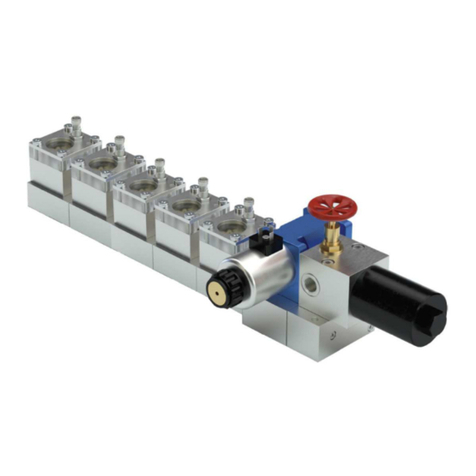
Lincoln
Lincoln SKF SMBM-X User manual
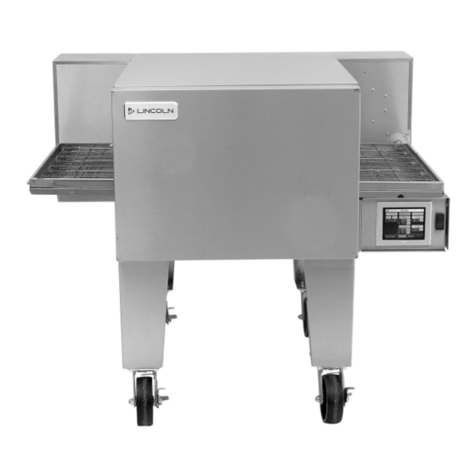
Lincoln
Lincoln Impinger Aperion 2424E User manual
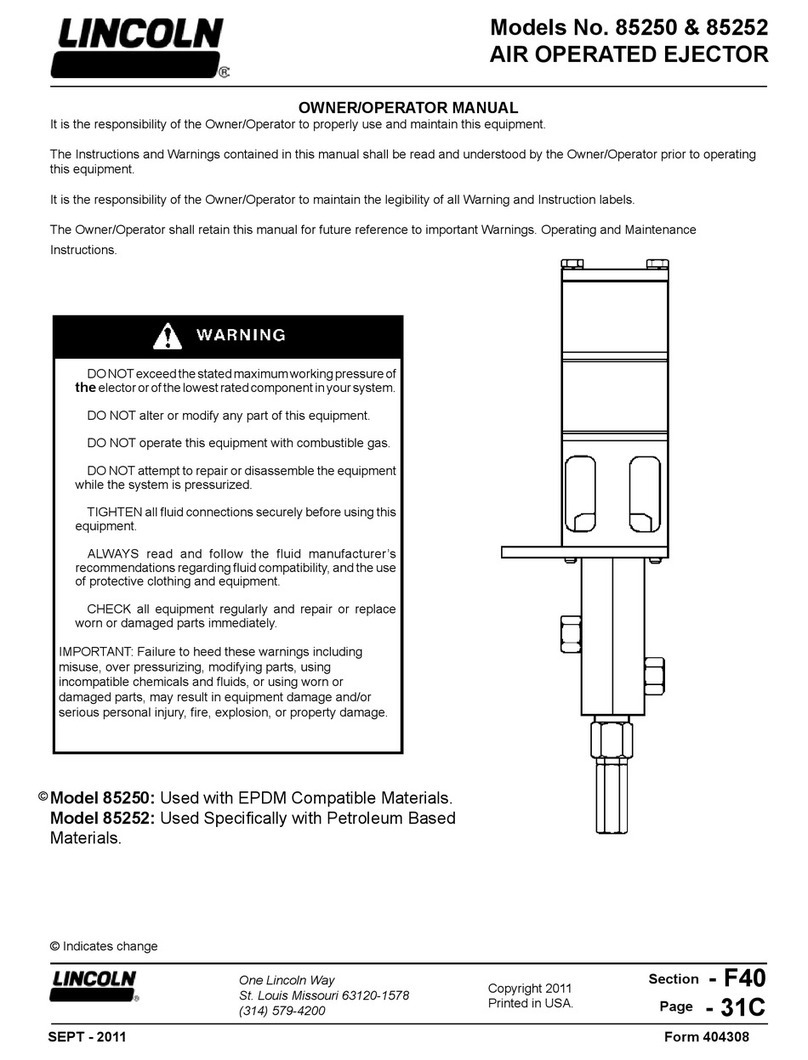
Lincoln
Lincoln 85250 Owner's manual
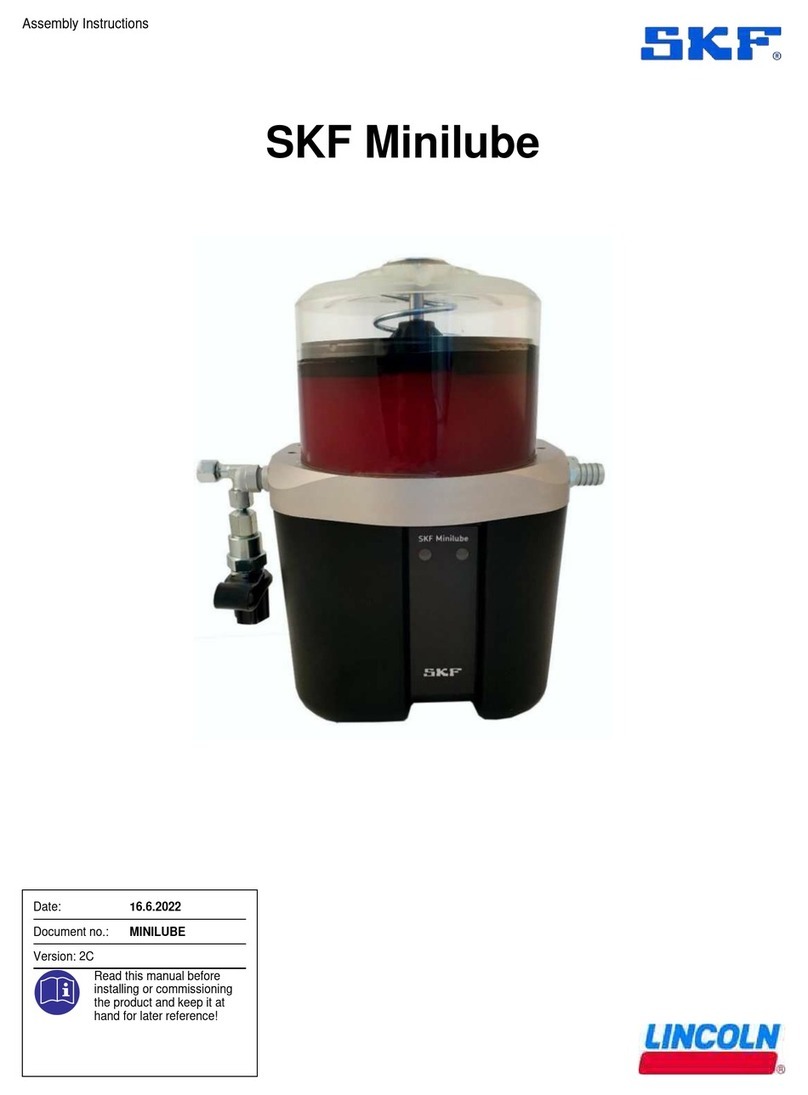
Lincoln
Lincoln SKF Minilube User manual
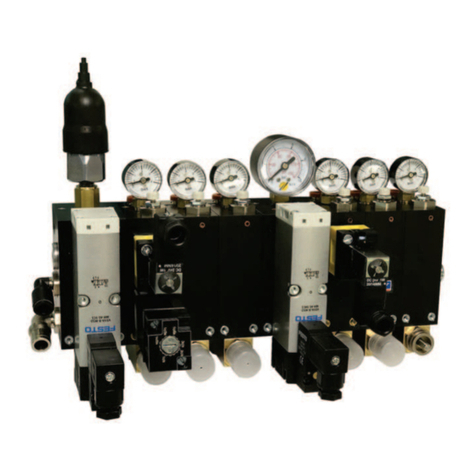
Lincoln
Lincoln SKF VTEC User manual
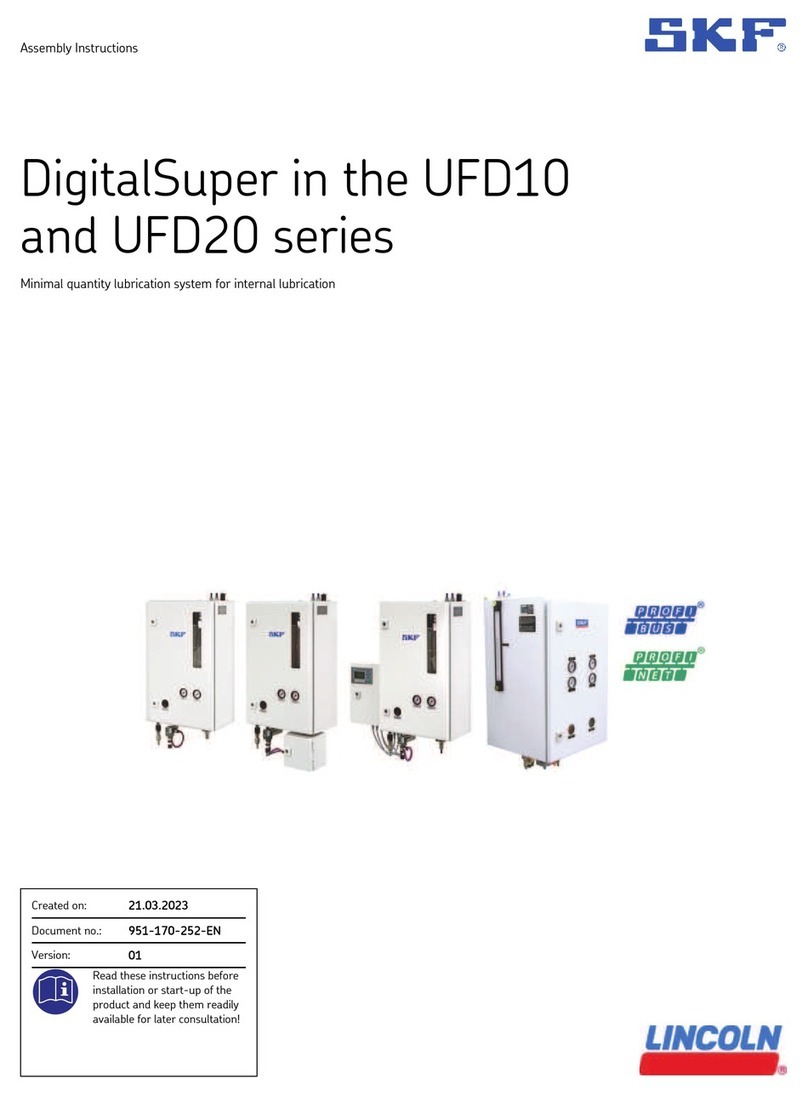
Lincoln
Lincoln SKF DigitalSuper UFD10 Series User manual
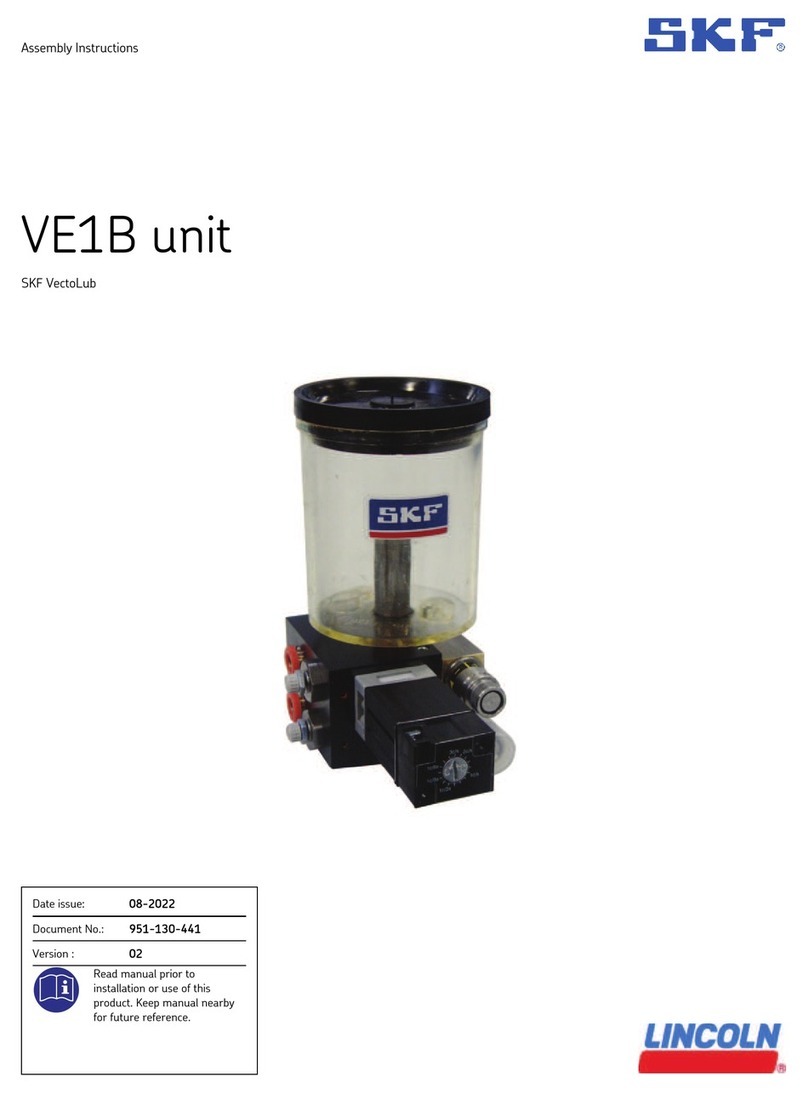
Lincoln
Lincoln SKF VectoLub VE1B unit User manual
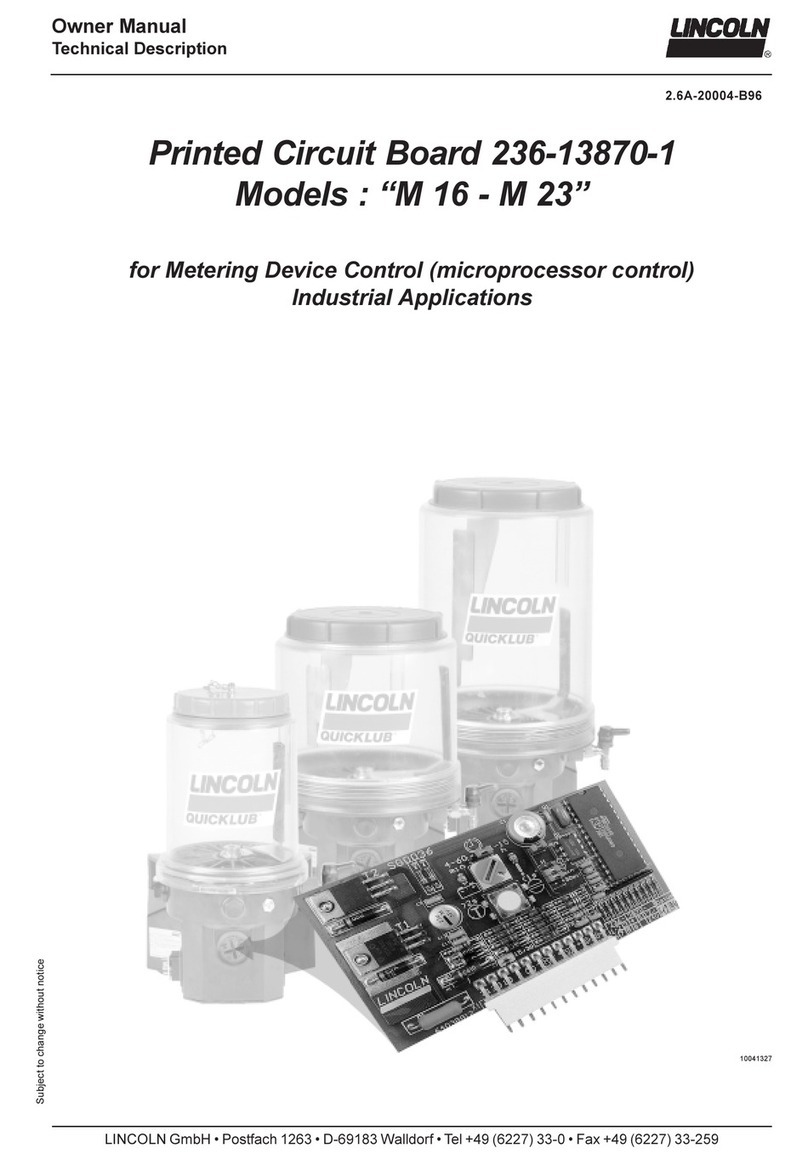
Lincoln
Lincoln M 16 User manual
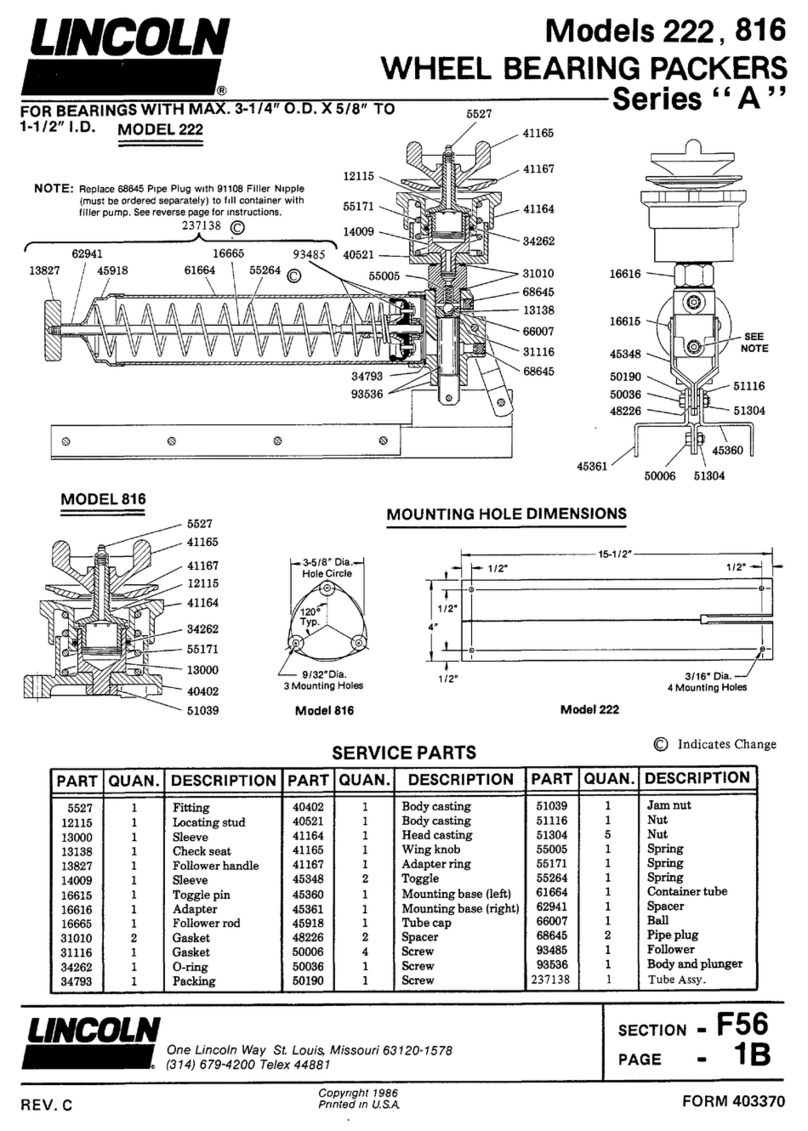
Lincoln
Lincoln A Series User manual
